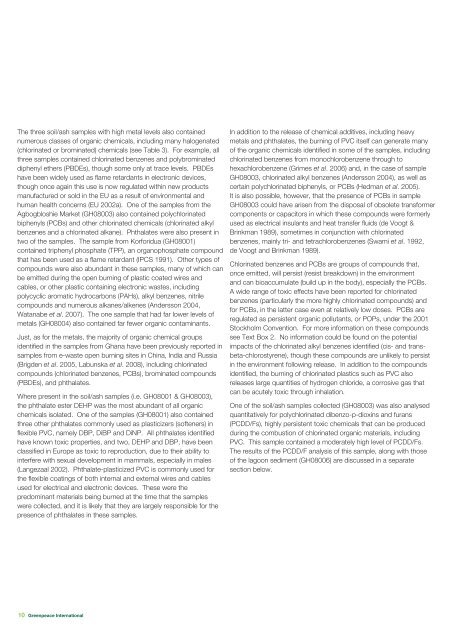Chemical contamination at e-waste recycling and ... - Greenpeace
Chemical contamination at e-waste recycling and ... - Greenpeace
Chemical contamination at e-waste recycling and ... - Greenpeace
Create successful ePaper yourself
Turn your PDF publications into a flip-book with our unique Google optimized e-Paper software.
The three soil/ash samples with high metal levels also contained<br />
numerous classes of organic chemicals, including many halogen<strong>at</strong>ed<br />
(chlorin<strong>at</strong>ed or bromin<strong>at</strong>ed) chemicals (see Table 3). For example, all<br />
three samples contained chlorin<strong>at</strong>ed benzenes <strong>and</strong> polybromin<strong>at</strong>ed<br />
diphenyl ethers (PBDEs), though some only <strong>at</strong> trace levels. PBDEs<br />
have been widely used as flame retardants in electronic devices,<br />
though once again this use is now regul<strong>at</strong>ed within new products<br />
manufactured or sold in the EU as a result of environmental <strong>and</strong><br />
human health concerns (EU 2002a). One of the samples from the<br />
Agbogbloshie Market (GH08003) also contained polychlorin<strong>at</strong>ed<br />
biphenyls (PCBs) <strong>and</strong> other chlorin<strong>at</strong>ed chemicals (chlorin<strong>at</strong>ed alkyl<br />
benzenes <strong>and</strong> a chlorin<strong>at</strong>ed alkane). Phthal<strong>at</strong>es were also present in<br />
two of the samples. The sample from Korforidua (GH08001)<br />
contained triphenyl phosph<strong>at</strong>e (TPP), an organophosph<strong>at</strong>e compound<br />
th<strong>at</strong> has been used as a flame retardant (IPCS 1991). Other types of<br />
compounds were also abundant in these samples, many of which can<br />
be emitted during the open burning of plastic co<strong>at</strong>ed wires <strong>and</strong><br />
cables, or other plastic containing electronic <strong>waste</strong>s, including<br />
polycyclic arom<strong>at</strong>ic hydrocarbons (PAHs), alkyl benzenes, nitrile<br />
compounds <strong>and</strong> numerous alkanes/alkenes (Andersson 2004,<br />
W<strong>at</strong>anabe et al. 2007). The one sample th<strong>at</strong> had far lower levels of<br />
metals (GH08004) also contained far fewer organic contaminants.<br />
Just, as for the metals, the majority of organic chemical groups<br />
identified in the samples from Ghana have been previously reported in<br />
samples from e-<strong>waste</strong> open burning sites in China, India <strong>and</strong> Russia<br />
(Brigden et al. 2005, Labunska et al. 2008), including chlorin<strong>at</strong>ed<br />
compounds (chlorin<strong>at</strong>ed benzenes, PCBs), bromin<strong>at</strong>ed compounds<br />
(PBDEs), <strong>and</strong> phthal<strong>at</strong>es.<br />
Where present in the soil/ash samples (i.e. GH08001 & GH08003),<br />
the phthal<strong>at</strong>e ester DEHP was the most abundant of all organic<br />
chemicals isol<strong>at</strong>ed. One of the samples (GH08001) also contained<br />
three other phthal<strong>at</strong>es commonly used as plasticizers (softeners) in<br />
flexible PVC, namely DBP, DiBP <strong>and</strong> DiNP. All phthal<strong>at</strong>es identified<br />
have known toxic properties, <strong>and</strong> two, DEHP <strong>and</strong> DBP, have been<br />
classified in Europe as toxic to reproduction, due to their ability to<br />
interfere with sexual development in mammals, especially in males<br />
(Langezaal 2002). Phthal<strong>at</strong>e-plasticized PVC is commonly used for<br />
the flexible co<strong>at</strong>ings of both internal <strong>and</strong> external wires <strong>and</strong> cables<br />
used for electrical <strong>and</strong> electronic devices. These were the<br />
predominant m<strong>at</strong>erials being burned <strong>at</strong> the time th<strong>at</strong> the samples<br />
were collected, <strong>and</strong> it is likely th<strong>at</strong> they are largely responsible for the<br />
presence of phthal<strong>at</strong>es in these samples.<br />
In addition to the release of chemical additives, including heavy<br />
metals <strong>and</strong> phthal<strong>at</strong>es, the burning of PVC itself can gener<strong>at</strong>e many<br />
of the organic chemicals identified in some of the samples, including<br />
chlorin<strong>at</strong>ed benzenes from monochlorobenzene through to<br />
hexachlorobenzene (Grimes et al. 2006) <strong>and</strong>, in the case of sample<br />
GH08003, chlorin<strong>at</strong>ed alkyl benzenes (Andersson 2004), as well as<br />
certain polychlorin<strong>at</strong>ed biphenyls, or PCBs (Hedman et al. 2005).<br />
It is also possible, however, th<strong>at</strong> the presence of PCBs in sample<br />
GH08003 could have arisen from the disposal of obsolete transformer<br />
components or capacitors in which these compounds were formerly<br />
used as electrical insulants <strong>and</strong> he<strong>at</strong> transfer fluids (de Voogt &<br />
Brinkman 1989), sometimes in conjunction with chlorin<strong>at</strong>ed<br />
benzenes, mainly tri- <strong>and</strong> tetrachlorobenzenes (Swami et al. 1992,<br />
de Voogt <strong>and</strong> Brinkman 1989).<br />
Chlorin<strong>at</strong>ed benzenes <strong>and</strong> PCBs are groups of compounds th<strong>at</strong>,<br />
once emitted, will persist (resist breakdown) in the environment<br />
<strong>and</strong> can bioaccumul<strong>at</strong>e (build up in the body), especially the PCBs.<br />
A wide range of toxic effects have been reported for chlorin<strong>at</strong>ed<br />
benzenes (particularly the more highly chlorin<strong>at</strong>ed compounds) <strong>and</strong><br />
for PCBs, in the l<strong>at</strong>ter case even <strong>at</strong> rel<strong>at</strong>ively low doses. PCBs are<br />
regul<strong>at</strong>ed as persistent organic pollutants, or POPs, under the 2001<br />
Stockholm Convention. For more inform<strong>at</strong>ion on these compounds<br />
see Text Box 2. No inform<strong>at</strong>ion could be found on the potential<br />
impacts of the chlorin<strong>at</strong>ed alkyl benzenes identified (cis- <strong>and</strong> transbeta-chlorostyrene),<br />
though these compounds are unlikely to persist<br />
in the environment following release. In addition to the compounds<br />
identified, the burning of chlorin<strong>at</strong>ed plastics such as PVC also<br />
releases large quantities of hydrogen chloride, a corrosive gas th<strong>at</strong><br />
can be acutely toxic through inhal<strong>at</strong>ion.<br />
One of the soil/ash samples collected (GH08003) was also analysed<br />
quantit<strong>at</strong>ively for polychlorin<strong>at</strong>ed dibenzo-p-dioxins <strong>and</strong> furans<br />
(PCDD/Fs), highly persistent toxic chemicals th<strong>at</strong> can be produced<br />
during the combustion of chlorin<strong>at</strong>ed organic m<strong>at</strong>erials, including<br />
PVC. This sample contained a moder<strong>at</strong>ely high level of PCDD/Fs.<br />
The results of the PCDD/F analysis of this sample, along with those<br />
of the lagoon sediment (GH08006) are discussed in a separ<strong>at</strong>e<br />
section below.<br />
10 <strong>Greenpeace</strong> Intern<strong>at</strong>ional

















